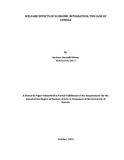| dc.contributor.author | Otieno, Gastone O | |
| dc.date.accessioned | 2013-11-12T07:19:17Z | |
| dc.date.available | 2013-11-12T07:19:17Z | |
| dc.date.issued | 2013-10 | |
| dc.identifier.citation | Otieno,Gastone O.;October,2013.Welfare Effects Of Economic Integration: The Case Of Comesa. | en |
| dc.identifier.uri | http://erepository.uonbi.ac.ke:8080/xmlui/handle/123456789/58577 | |
| dc.description.abstract | This paper looks at welfare effects of economic integration of COMESA regional bloc.
More specifically the study seeks to find out whether COMESA RTA is trade creating or
trade diverting. The analysis uses annual data from the year 2006 to 2010 of the Customs
Union because it influence trade over a longer period of time amidst several agreements
signed by developing countries. The study has used a panel data analysis of eighteen
COMESA member countries and their major trading partners to determine the effects of
regional trade arrangements using the augmented gravity model of trade. A random
verses fixed effect models were used to estimate the model putting into consideration the
time invariant variables. We use the hausman test to determine the choice of the model to
be estimated. The results showed that the variables used are significant and determines
the effects of bilateral trade on welfare. The estimated results showed that exporters GDP
significantly improves export trade by more than 100%; while the importers GDP does
less proportionately. The size (population) variable coefficients are positive and
significant. The estimated results also shows that resistant factor (distance) as a proxy
for transportation cost plays an important role in determining trade flows. In addition,
the COMESA dummy variables also have their expected coefficients but only the importer
dummy that are significant. In conclusion, COMESA RTA in overall shows that it’s a
building block; that is, it liberalizes trade more internally than it diverts trade from the
rest of the world. This can translate into welfare improvements with proper mechanisms
to monitor the equitable distribution of the national income to the citizens. It’s therefore
recommended that, member countries governments promote more active regional
participation that promote welfare gain that can be distributed to the nationals in terms
of development projects geared towards alleviating poverty in the region. | en |
| dc.language.iso | en | en |
| dc.publisher | University of Nairobi | en |
| dc.title | Welfare Effects of Economic Integration: the Case of Comesa | en |
| dc.type | Thesis | en |
| local.publisher | College of Humanities and Social Sciences | en |

